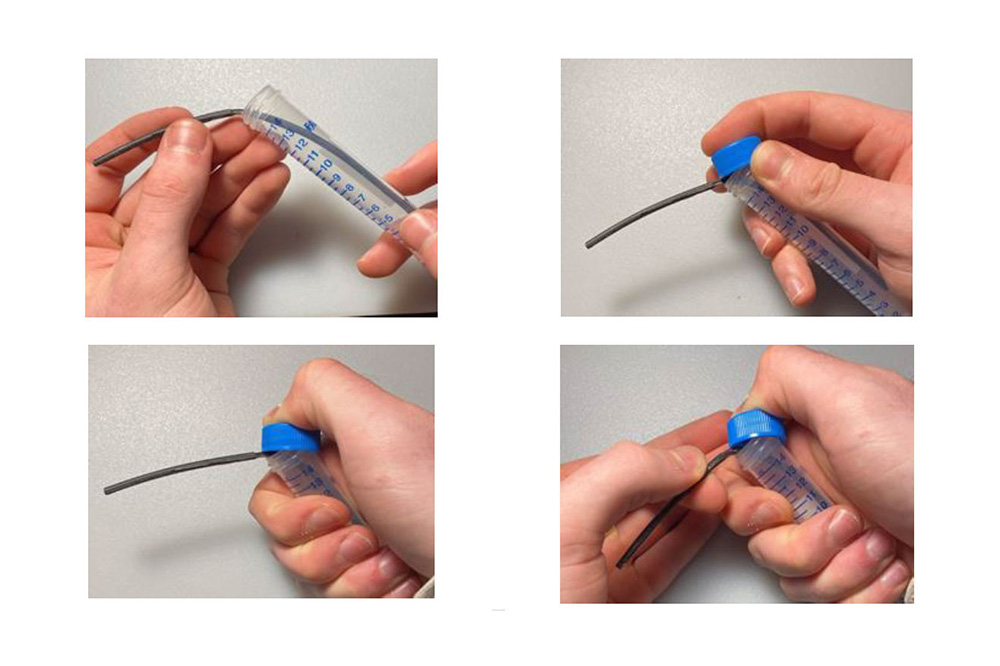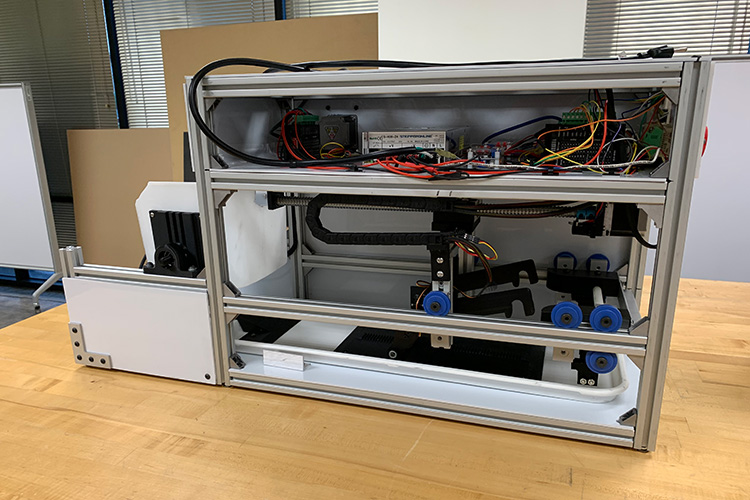
With assistance from University of Texas at Dallas engineering students, one of the University’s spinoff companies is developing a flexible and more accurate 3D-printed nasopharyngeal swab for infectious disease testing.
Adaptive3D, a Plano, Texas, 3D-printing company, began the project in 2020 to boost the supply of nasal swabs due to shortages at the beginning of the COVID-19 pandemic. The swabs are made with the company’s photoresin, a rubber material that can curve with the nasal cavity, resulting in less discomfort for patients than with traditional swabs. The material is based on technology and reactions chemistries developed in a campus lab.
Students in UTDesign, a senior capstone program, played a significant role in developing the swabs, which Adaptive3D continues to refine, said Dr. Walter Voit BS’05, MS’06, the company’s founder and CEO.

Voit, associate professor of materials science and engineering and of mechanical engineering in the Erik Jonsson School of Engineering and Computer Science, developed the initial technology that led to the photoresin as an early-career faculty member. He developed the final photoresin at Adaptive3D, which he launched in 2010 through the UT Dallas Venture Development Center. In May, the company became a subsidiary of Desktop Metal Inc., an additive manufacturing company based in Burlington, Massachusetts.
“UT Dallas student research was an important component of this project,” Voit said. “Innovation is the hallmark of progress, and through programs like UTDesign, we are able to tap into incredible student creativity and perspective built upon a firm fundamental, mathematical view of design and mechanical forces.”
Adaptive3D sponsored two projects through the senior capstone program. The company challenged one team to find a way to design a breakpoint for the rubbery swab and asked another team to develop an automated process to sort and assemble the swabs after manufacturing.
The second team’s automated system won second place in the Student Manufacturing Design Competition at the American Society of Mechanical Engineers’ Manufacturing Science and Engineering Conference in June.
The company is continuing to refine the swabs by increasing their viral loads after discovering that the product has the potential to improve the accuracy of future tests.

“We will pick up from where the student teams left off with their designs, working with our sister company, EnvisionTEC, also recently purchased by Desktop Metal, to find a development pathway to scaling their systems to handle high-volume manufacturing of millions of swabs per month,” Voit said.
Once 3D-printed, the swabs must go through several steps, including the removal of a slippery polymer resin and a curing process. Trent Sakakini BS’21, now a UT Dallas mechanical engineering graduate student, led the team that developed the award-winning automated sorting and packaging system.
“No one had done this before, so we had no examples to draw from,” Sakakini said. “It’s cool to look back and see how we started with nothing, and then nine months down the line, we had a working prototype.”
The pandemic presented challenges for students, who worked remotely and coordinated around reduced UTDesign lab capacity to protect users’ safety.
“We received our project when there was a shortage of nasal swabs,” said engineering team lead Trevor Schmaeling BS’21, now a graduate student in systems engineering. “That added an extra motivating factor in terms of us wanting to get it done.”
“UT Dallas student research was an important component of this project. Innovation is the hallmark of progress, and through programs like UTDesign, we are able to tap into incredible student creativity and perspective built upon a firm fundamental, mathematical view of design and mechanical forces.”
Dr. Walter Voit BS’05, MS’06, associate professor of materials science and engineering and of mechanical engineering in the Erik Jonsson School of Engineering and Computer Science
Schmaeling, who hopes to work in the medical device industry, said the project gave him valuable experience that was especially relevant during the pandemic.
“We also were excited about the fact that our project was for a company created by UT Dallas faculty,” Schmaeling said. “The fact that we, as UTD students, got to contribute to the company was like icing on the cake for us.”
Members of Schmaeling’s team, which designed the nasopharyngeal swab’s breakpoint, included Jacob Feret BS’21; Rohclem Lim, mechanical engineering senior; Darrah Merillat BS’21, biomedical engineering graduate student; Ethan Nichols BS’21; and Andrew Riding BS’21.
Sakakini’s teammates included Josiah Go BS’21; Tobias Hynes BS’21; Petro John BS’21, mechanical engineering graduate student; Thien Nguyen BS’21; and Jayaram Rajagopalan BS’21.